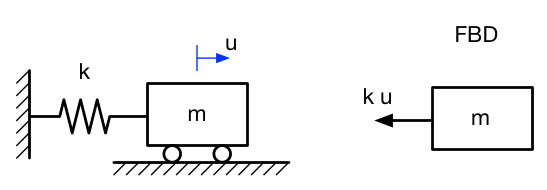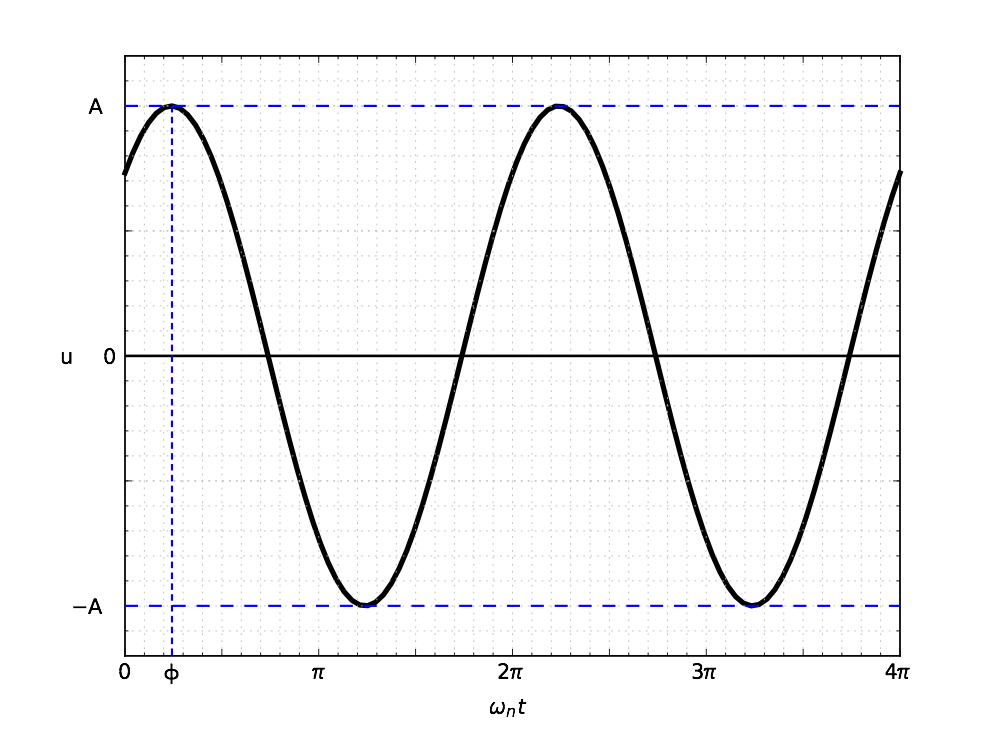Free, undamped vibrations
March 16, 2014 at 1:23 PM by Dr. Drang
Let’s start with the simplest vibrating system, a spring and a mass:
(You can ignore the free body diagram in the right half for the moment. We’ll return to it in a bit.)
There are lots of oscillating systems that have the same behavior as the spring-mass system. The pendulum is an important historical example, because it was studied by Galileo and Huygens and was an early means for accurate timekeeping. On the electrical side, there’s the inductor-capacitor (LC) circuit, and in acoustics, there’s the Helmholtz resonator. Even within mechanical systems, we can change the way our spring-mass system looks by using different types of springs. We could put the mass at the end of a light cantilever beams, for example, or in the center of a stretched string. These are all analogous systems because the equations that govern their behavior take the same mathematical form.
The key assumptions in the analysis of the spring-mass system are that the mass of the spring is small enough to be ignored and that it follows Hooke’s Law, i.e., that the force in the spring is proportional to the amount it’s stretched. The constant of proportionality is .
I’m going to use to represent the displacement of the mass from its “natural” position, which is where the spring is neither stretched nor compressed. You might be more comfortable with using for this value, but don’t get thrown by notation. is commonly used for “displacement in the direction,” and we’ll be using for something else in a later post.
The spring-mass system is called a single degree of freedom (SDOF) system, because all of its behavior can be described by a single function, , and its derivatives. Later on we’ll look at multiple degree of freedom (MDOF) systems and continuous systems, which have an infinite number of degrees of freedom.
With as displacement, the velocity of the mass will be
and the acceleration will be
Using dots over the letters to represent differentiation with respect to time is pretty common in mechanics because it’s nice and compact. Newton used it, so it has a good pedigree.
Looking back now at the free body diagram, we see that there’s only one horizontal force acting on the mass.1 It’s the force from the spring which acts in the negative (left) direction when the mass is displaced in the positive (right) direction. Applying Newton’s Second Law, we get
or
This is a second order differential equation with constant coefficients, so it’s one of the few differential equations that can be solved in closed form. The solution is
where is the displacement at time zero, is the velocity at time zero, and
is the natural frequency of the oscillation.
You may remember from differential equations class that second order differential equations have two constants of integration, which are determined by either the boundary conditions or initial conditions of the system. In our solution above, and are the initial conditions, and this is often a convenient way to express the solution. If, for example, we stretch the spring out a distance and release it from rest, the solution will be just
because .
We’re not, however, restricted to using and as our constants of integration. Another form of the solution is
where is the amplitude of the oscillation and is the phase. If we plot this function, we get a sinusoid that varies between and and is horizontally offset by from a standard cosine.
The amplitude and phase are related to the initial conditions through these formulas:
Let’s return now to the most interesting characteristic of the system, the natural frequency. First, what are its units? The spring constant, , has dimensions of force per unit length, which we can write this way, using square bracket notation:
The force part can be broken down further into mass, length, and time:
And therefore the units of natural frequency are
which is reciprocal time, e.g., “per second” or, more commonly, “radians per second.” Recall that the radian is dimensionless, so putting it in the numerator is mathematically no different that putting the number one in the numerator. It’s just easier to say “five radians per second” than “five per second.”
When frequency of any type is expressed in radians per second, we often call it circular frequency and always give it the symbol . Circular frequency is mathematically convenient, but not easy to measure. Frequencies are usually measured in cycles per second, or hertz, and are given the symbol . Because there are radians in a cycle, and are proportional to one another, with .
Moving back to our spring-mass system, we can say that or
The natural period of the system is the inverse of the cyclic natural frequency:
If you look back at the graph above, you’ll see that I used for the horizontal axis rather than just . This trick makes it easy to see that the cycle repeats itself whenever increases by or, equivalently, whenever increases by . Which is another way of showing that the period of the system is .
So we could write our solution it at least two other ways,
and
depending on what’s most convenient for us, which may change from one situation to another.
Measuring the period of a spring-mass system is fairly easy. Imagine we had such a system oscillating in front of us. We could start a stopwatch when the mass was at its extreme right and stop it the next time it reached that position. The reading on the stopwatch would be , and we could calculate the two types of frequency using the formulas above.
As we’ll see in later posts, the natural frequency of a system determines how it responds to dynamic forces. Neither the spring stiffness nor the mass matter as much as the ratio between the two.
One last thing. Looking back at the graph again, you’ll see that the function is completely determined by the three parameters, (which we could convert to or ), , and . Of these, the least important is . In fact, if you think about it, the phase is entirely arbitrary—it’s determined by when we decide to set to zero. Consider again our experiment for measuring the period. We started our stopwatch (set ) when the mass was at its rightmost point. In doing so, we were setting . Had we chosen to start our watch when the mass was at its leftmost point, we’d have set . All we’re doing is shifting the origin of the horizontal axis in our graph. The spring and mass don’t care—they move the way they want without regard to when we start the watch. This is a feature we can take advantage of by choosing values of that make the math easier. I’ll do that in the next vibration post, which will cover damped vibrations.
In the meantime, you might want to take a look at John D. Cook’s series of four posts (one, two, three, and four) on SDOF systems from last year. I think it’s interesting to compare how he and I approach this problem. Although he’s toward the applied end of mathematicians and I’m toward the mathematical end of engineers, and the problem we’re solving is exactly the same, we still look at the problem in ways that betray our origins. This will become more clear as I move into damped and forced vibrations.
-
We’re ignoring the vertical direction because there’s no motion in that direction. ↩


